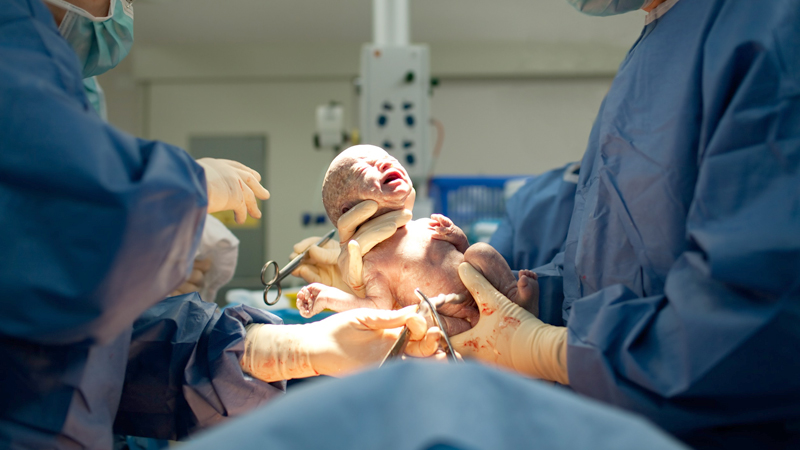
Normal Delivery / Cesarean Section
Normal Delivery and Cesarean Section (C-section) are two primary methods of childbirth. Each method has its indications, benefits, risks, and specific care protocols. Here is a detailed comparison and overview of both types of delivery.
Normal Delivery (Vaginal Delivery)
Indications
- Uncomplicated Pregnancy: No major medical or obstetric complications.
- Spontaneous Labor: Labor that begins on its own without induction.
- Full-Term Pregnancy: Typically between 37 and 42 weeks of gestation.
Process
- Early Labor: The cervix begins to dilate and efface. Contractions become more regular and increase in intensity.
- Active Labor: The cervix dilates from 6 to 10 centimeters. Contractions are stronger, closer together, and more painful.
- Transition: The final part of active labor, where the cervix fully dilates to 10 centimeters.
- Pushing and Delivery: The mother pushes with contractions to help the baby move through the birth canal. The baby's head crowns, and then the baby is born.
- Delivery of Placenta: After the baby is delivered, contractions continue to help expel the placenta.
Benefits
- Shorter Recovery Time: Most women recover faster and can go home sooner compared to a C-section.
- Lower Infection Risk: Less risk of infection as there is no major abdominal surgery.
- Natural Process: Fewer medical interventions and a more natural childbirth experience.
Risks
- Perineal Tears: Tears in the tissue between the vagina and anus.
- Prolonged Labor: Labor can be lengthy and exhausting.
- Fetal Distress: The baby may experience distress during labor.
Postpartum Care
- Monitoring: Regular monitoring of the mother and baby immediately after delivery.
- Pain Management: Pain relief for any perineal tears or episiotomy.
- Rest and Recovery: Encouraging rest and proper nutrition for recovery.
- Breastfeeding Support: Assistance with initiating breastfeeding.
Cesarean Section (C-section)
Indications
- Medical Conditions: Pre-existing conditions such as heart disease or diabetes.
- Obstetric Complications: Placenta previa, placental abruption, or umbilical cord prolapse.
- Fetal Distress: The baby shows signs of distress during labor.
- Breech Presentation: The baby is not in the head-down position.
- Previous C-section: Some women may choose or need to have a repeat C-section.
- Multiple Births: Twins or higher-order multiples.
Process
- Preparation: The mother is given anesthesia (usually spinal or epidural).
- Incision: A horizontal incision is made in the lower abdomen and uterus.
- Delivery: The baby is delivered through the incision.
- Placenta Removal: The placenta is removed, and the incisions are closed with sutures.
Benefits
- Planned and Controlled: Provides a controlled environment, which can be scheduled in advance.
- Life-Saving: Critical for conditions where vaginal delivery would pose risks to the mother or baby.
- Less Trauma: Avoids potential trauma to the baby from a difficult vaginal birth.
Risks
- Longer Recovery: Recovery time is typically longer compared to vaginal delivery.
- Surgical Risks: Increased risk of infection, blood loss, and complications from anesthesia.
- Future Pregnancies: Potential complications in future pregnancies, such as uterine rupture or placenta accreta.
Postpartum Care
- Hospital Stay: Usually a longer stay (3-4 days) to monitor recovery.
- Pain Management: Medication for pain control and to manage discomfort from the incision.
- Activity Restrictions: Limitations on lifting, driving, and strenuous activities for several weeks.
- Incision Care: Instructions on how to care for the surgical incision to prevent infection.
Choosing the Right Method
The choice between a normal delivery and a C-section is based on medical necessity, the health of the mother and baby, and personal preferences. It is important to have open discussions with healthcare providers to understand the best and safest options for delivery.
Summary
Both normal delivery and C-sections have their respective benefits and risks. Normal delivery is generally preferred for its natural process and quicker recovery, while C-sections are essential for certain medical conditions and complications. Proper prenatal care, thorough discussions with healthcare providers, and understanding the indications and potential outcomes of each method can help ensure a safe and healthy delivery experience.
